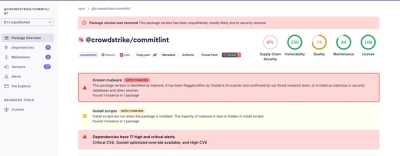
Research
Malicious fezbox npm Package Steals Browser Passwords from Cookies via Innovative QR Code Steganographic Technique
A malicious package uses a QR code as steganography in an innovative technique.
pypagination
Advanced tools
To import:
from pypagination import paginate
Call the paginate function:
paginate(150):
{
totalItems: 150,
currentPage: 1,
pageSize: 10,
totalPages: 15,
startPage: 1,
endPage: 10,
startIndex: 0,
endIndex: 9,
pages: [ 1, 2, 3, 4, 5, 6, 7, 8, 9, 10 ]
}
paginate(150, 7): totalItems: 150, currentPage: 7, pageSize: 15
{
totalItems: 150,
currentPage: 7,
pageSize: 10,
totalPages: 15,
startPage: 2,
endPage: 11,
startIndex: 60,
endIndex: 69,
pages: [ 2, 3, 4, 5, 6, 7, 8, 9, 10, 11 ]
}
paginate(150, 7, 15, 5) totalItems: 150, currentPage: 7, pageSize: 15, maxPages: 5
{
totalItems: 150,
currentPage: 7,
pageSize: 15,
totalPages: 10,
startPage: 5,
endPage: 9,
startIndex: 90,
endIndex: 104,
pages: [ 5, 6, 7, 8, 9 ]
}
The paginate function accepts the following parameters:
totalItems (required) - the total number of items to be pagedcurrentPage (optional) - the current active page, defaults to the first pagepageSize (optional) - the number of items per page, defaults to 10maxPages (optional) - the maximum number of page navigation links to display, defaults to 10The output of the paginate function is an object containing all the information needed to display the current page of items in the view and the page navigation links.
FAQs
A small library to paginate through json objects
We found that pypagination demonstrated a healthy version release cadence and project activity because the last version was released less than a year ago. It has 1 open source maintainer collaborating on the project.
Did you know?

Socket for GitHub automatically highlights issues in each pull request and monitors the health of all your open source dependencies. Discover the contents of your packages and block harmful activity before you install or update your dependencies.

Research
A malicious package uses a QR code as steganography in an innovative technique.

Research
/Security News
Socket identified 80 fake candidates targeting engineering roles, including suspected North Korean operators, exposing the new reality of hiring as a security function.

Application Security
/Research
/Security News
Socket detected multiple compromised CrowdStrike npm packages, continuing the "Shai-Hulud" supply chain attack that has now impacted nearly 500 packages.